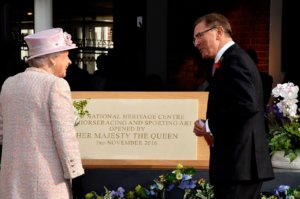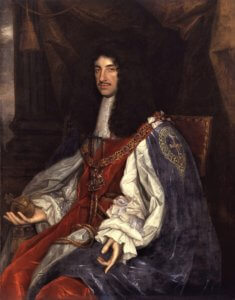The visitors who flock to Newmarket year by year are often surprised to learn about the town’s Royal connections and its unique history and heritage which has spanned the ages. As part of the Queen’s Jubilee Platinum celebrations, Discover Newmarket has created a new guided experience providing a fascinating insight into the town’s Royal story. Combining a walking tour around the town centre with a private tour of Palace House, Charles I’s former home, and is now part of the National Horseracing Museum complex, which was opened by Her Majesty, Queen Elizabeth II, in 2016.

Find out more about the town’s royal origins in this account written by Sandra Easom Chair of Newmarket Local History Society.
Newmarket is surprisingly modest about its Royal connections and it could well boast even more Royal connections, and over a much longer period, than most places in England. Recent archaeological excavations have found evidence of occupation from ancient times, including the Stone Age. The first recorded local connection to Royalty goes back about 2000 years. During the Iron Age the Iceni tribe ruled these lands and had a major settlement near Exning. Their most famous Queen, Boudicca or Boadicea, organised a major rebellion against the Romans in 61 AD and almost succeeded in driving them out of Britain.
King Anna, ruler of the Anglo-Saxon Kingdom of East Anglia (he died 654 AD), probably instigated the building of the huge Dyke which runs for 7 miles through Newmarket Heath. Archaeology has linked it to that period and in those troubled times it was a defensive measure to plug a gap between the fen edge at Reach and the forest at Woodditton. Anna’s most famous daughter was Queen Etheldreda (or Saint Etheldreda) who was born at his palace in Exning, said to have stood where St Martin’s Church stands today. Etheldreda was responsible for the first abbey at Ely, later to become the Cathedral (which incidentally, on a clear day can be seen from Warren Hill, some 15 miles away).
A Royal Charter instigated Newmarket’s twice weekly market circa 1200 AD, making it one of the oldest Medieval markets in Suffolk. The weekly markets and later annual fairs made this a bustling farming community.
Tournaments were held on Newmarket Heath during the Middle Ages. However, the Plantagenet King Edward II was fearful of plots and rebellion against him in large gatherings and issued an order banning such tournaments in 1313.
After that Newmarket had to wait until February 1604 for the next major Royal event – the arrival of King James I. It was he who was responsible for the first two Royal Palaces here and James and his son Charles (later Charles I) began to travel from London to use the town as a sort of holiday resort.
Horseracing, in the form of private matches, took place at this time and Charles is reputed to have built the first grandstand on the Heath for his own use. However, races, cockfighting and the many other sports and games which the Stuarts loved, were curtailed by the Civil War. Sadly, King Charles I was kept prisoner in his Newmarket palace on the way to his execution – perhaps the least happy of Newmarket’s Royal connections.

King James’ Palace was in a poor state by the time of his grandson’s, King Charles II’s, Restoration in 1660. Charles must have had happy memories of his times in Newmarket with his father and grandfather. Certainly, he soon returned to the town and took the decision to build a new, grander palace further along the High Street. So began the time most people associate with horseracing on Newmarket Heath.
In the centuries that followed a succession of Royal visitors made their way to Newmarket’s Palace and the races. Other attractions might have been the town’s numerous cock pits, gambling dens and inns. The histories that were woven into Newmarket’s fabric, turning the little village into a town, are too long to tell here. King William III and Queen Mary II, Queen Anne, The Prince Regent, King Edward VII, King George V and of course, Queen Elizabeth II and Queen Elizabeth, the Queen Mother, have all appreciated this unique town and its racecourses – set in the largest expanse of cultivated heath land in the world.

The Newmarket Racing Royalty tour runs on a number of dates throughout the year and private tours can also be booked. This tour is also suitable for groups of all sizes. Click here to find out more and join us as we walk in the footsteps of Royalty in Newmarket.

30/04/2024
The going’s good in Newmarket this spring and summer
The excitement’s mounting at Newmarket, which has set a thrilling pace for the 2024 racing season.
08/04/2024
Discover Newmarket Enters New Partnership with National Horseracing Museum
Discover Newmarket will manage Visitor Services on behalf of the National Horseracing Museum in an exciting new partnership agreed last week.
18/03/2024
The Story of The Tin Man
Retiring as a living legend at the National Stud
Since arriving at the National Stud in April 2022, this retired legend is most definitely a firm favourite amongst our tour attendees.
06/03/2024
Easter Activities in and around Newmarket
With Easter just around the corner, there’s the promise of warmer weather and the chance to celebrate over the long weekend, is in sight.
29/02/2024
Time called for long-standing employee, Alan Grimwood, at Corney and Barrow
Alan is a familiar face to many in and around Newmarket as he drives the Corney and Barrow branded, red van delivering wines and spirits.
19/02/2024
Ely Cathedral: A Celebration of Bridal Gowns Exhibition
Just a stones throw away from Newmarket, Ely Cathedral is highly regarded by historians and architects from all over the world for its beauty and size.
31/01/2024
Your Guide to making Valentine’s Day Special
Show them how much they’re loved, with our special Valentine’s Day Guide.
Visit East of England and see where they became Master of the Air!



